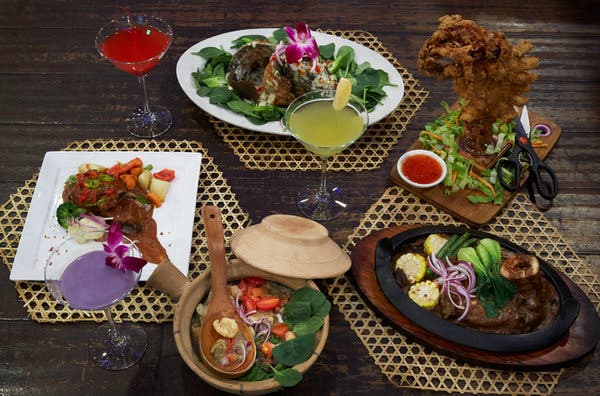You can see the calamares gigantes coming from across the room, tall and swaying, a fountaining of deep-fried squid. A skewer, planted vertically, holds it all upright, with the tentacles massed at the top, curling upward and suggesting a wild-haired puppet.
This is a street-food snack across Asia, found at night markets in the Philippines, South Korea and Taiwan, to be torn off the stick with the teeth. At Kusina Pinoy Bistro, a Filipino restaurant in Woodside, Queens, scissors are provided, to aid in sharing.
Still, eating it is a messy (and happy) business, oil glossing the fingers. The experience is less about the specific flavors and textures, although those are pleasing enough — pliant flesh, rugged crust, punctuations of salt and pepper — than the festive comedy of snipping and catching tubes and tentacles, to dole out around the table.

The teetering towers of squid are everywhere at Kusina Pinoy Bistro, which opened in March on a block dominated by storefronts catering to Woodside’s immigrant Filipino population: turo-turo (point-point) steam-table joints and shipping offices specializing in balikbayan (loosely translated as “homecoming”) boxes packed with presents for relatives back home.
The restaurant — run by a team that includes a nurse, a physician assistant in interventional radiology, and an industrial engineer, all moonlighting here — is a touch fancier than its neighbors, with a long, broad dining room, black banquettes, bamboo-hooded lamps and a galaxy of rainbow twinkle lights above. And while the menu focuses on the same homey fare found throughout this area, known as Little Manila, the kusina (kitchen) is also attuned to newer developments in Filipino cooking at home and abroad.
Bulalo is traditional, almost folkloric in its depth, a heavy stew of beef shank cooked bone-in, so the collagen melts into the broth, and served intact, with its marrow — to be sucked, not spooned out. But here, too, is bulalo steak, an innovation of a couple of decades back, in which the meat is simmered for two hours with lemongrass, bay leaf, black peppercorns and celery, then slaked with a gravy of thickened bulalo broth and crowded with mushrooms and lopped disks of corn cob on a sizzling plate.
Bicol Express is another classic, pork grown indolent in coconut milk and needled by chiles. The dish is named after the overnight sleeper train that once ran south from Manila to Naga City. (Service has been suspended for years because of typhoon damage.)
Here, ordinary pork is swapped out for bagnet, a specialty from a different region, Ilocos, in northern Luzon. This is pork belly, boiled and then deep-fried in its own leached oils, with the skin pricked before frying, creating little escape routes for the liquefied fat, to maximize crunch. It’s flesh and chicharrón at once, defiantly crispy even submerged in coconut milk.
Skewers of chicken inato come charred and dripping with a turmeric-stained marinade. The dish is cousin to chicken inasal, a style of barbecue that originated in Bacolod City in the Visayas region and notably shuns the soy sauce deployed elsewhere in the country, relying instead on vinegar and earthy-sweet ginger. (Inato is a contraction of the phrase atin ito, or “it’s ours,” popularized by the Visayan-based chain Jo’s Chicken Inato.)
The chef, Noriel Satira, from Pitogo in Quezon Province, does honor to old favorites: kaldereta with its rich base of tomatoes, minerally liver spread and Cheddar, spiked with pickles; laing, taro leaves still bearing their faint note of iron, wallowed in coconut milk and bagoong alamang (fermented shrimp paste); and ginisang munggo, mung beans steeped with tinapa (smoked fish), each spoonful a quiet insistence on stopping and slowing down.
For dessert, slabs of soft tofu slowly sink in a tall glass of dark cane sugar syrup, topped by swollen sago (tapioca pearls). Ube halaya, purple yam cooked down into something between custard and jam, is rolled into a lumpia wrapper and dropped in the deep fryer; under a fork, the shell crackles and the insides ooze out, vivid and royal.
Or hark back to the swelter of summer streets with a tube of ice candy, a meld of milk, sugar and maybe cantaloupe or avocado, depending on the day. It’s slapped down on a plate in a narrow plastic bag, knotted at one end; you’re supposed to gash it open with your teeth and half-sip, half-chug it. There’s no way to share, so it’s all yours.
Follow NYT Food on Twitter and NYT Cooking on Instagram, Facebook, YouTube and Pinterest. Get regular updates from NYT Cooking, with recipe suggestions, cooking tips and shopping advice.




